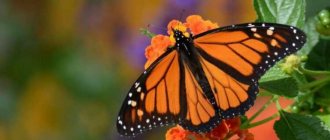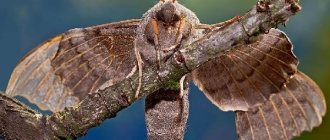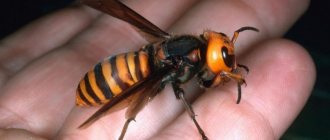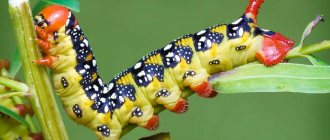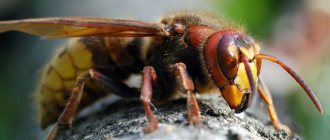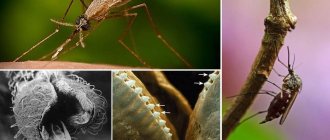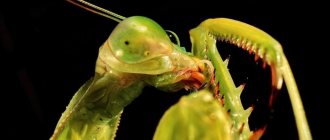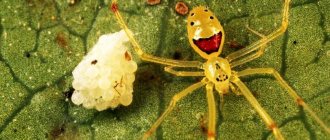08/25/2019 Category: Fashionable manicure
Thysania Agrippina is one of the largest moths. It belongs to the Noctuidae family. The most unusual thing is that a representative of this family belongs to the largest butterflies in the world, while all other moths have a wingspan of no more than a few centimeters. Sometimes she is called the White Witch.
In the semi-darkness, the silently rushing Agrippina can be confused with a flying bird, because its wingspan ranges from 22 to 31 cm.
Description
Looking at a butterfly, you involuntarily compare it with large birds. On the light background of the wings there is a clear pattern of alternating light and dark stripes and strokes, creating the illusion of plumage. These so-called feathers have a slightly metallic sheen. The marginal line is sinuous.
The color of butterflies varies from dark to light tones. The lower part of the body is brown with white spots. In males, the abdomen has a blue-violet sheen. The simple pattern on the wings of Tisani agrippina imitates the texture of tree bark and allows the butterfly to easily camouflage itself among vegetation.
One of the largest specimens was caught in Central America in Costa Rica. The length of its front wing reached 148 mm, and the wingspan was 270 mm. The butterfly with a wingspan of 280 mm was brought from Brazil.
Sailboat Maak
Not the largest butterfly on the planet, Papilio maackii is the largest representative of the order found in Russia. Lives on o. Kunashir, in Primorye, Amur region, Southern Sakhalin. The wingspan of females is 13.5 cm, males - 12.5 cm.
Maak's swallowtails have a very beautiful rainbow coloration. Males are distinguished by iridescence from malachite green to cobalt blue. In females, the color varies depending on the subspecies.
Tizania agrippina belongs to the order Lepidoptera, family Noctuidae. This is the largest moth of the moth family.
She is called differently, but each nickname is beautiful in its own way and fully corresponds to the unusual appearance of the winged beauty. Agrippa has several names, including the white witch, scoop agrippa, and sorceress.
Reproduction
Little is still known about the life cycle of the butterfly. There is an opinion that the caterpillar of Tisania agrippina feeds on the leaves of plants belonging to the genus Cassia from the legume family (hay leaves).
The length of the caterpillar is about 16 cm. Surely, like all butterflies, the White Witch lays eggs, they develop, going through all stages. A huge butterfly emerges from the pupa.
At the end of the 17th century, the entomologist and engraver from Germany Maria Merian (1647-1717) made a detailed description and depicted the classic cycle of metamorphosis in an engraving. She used the Tisani agrippina species as an example.
It is almost impossible to see the White Witch during the day. It camouflages itself on trees at a height of more than 3 meters. Having spread out her huge wings, she completely merges with the light background of the trunk. The frightened butterfly, deftly maneuvering, flies to another suitable tree and merges with its trunk.
Tizania agrippina
The South American tropical moth, or tisania agrippina, is a large nocturnal moth from the noctuid moth family. It is the largest butterfly in the world - in 1934, the largest individual with a wingspan of 30.8 cm was caught in Brazil. A similar specimen was caught in 1997 by entomologist Mario Callegari in northern Peru.
Distributed in Mexico, Central and South America. Considered a southern migrant to Texas.
Tizania agrippina
Butterflies are one of the largest groups of insects, including more than 137,000 species, the total estimated number of the order is up to 200 thousand species
Butterflies are the most popular group of insects for private collectors and scientists. This is due to the huge number of species, a wide variety of shapes, their wide distribution, variety of sizes and colors. Collecting butterflies originated a very long time ago. Back in the mid-18th century, English butterfly collectors called themselves Aurelians - from the Latin aureus - “golden” (a hint at the golden color of the pupae of some butterflies). In the mid-19th century, the interior of Victorian houses certainly included a glass cabinet, where, along with shells, fossils and minerals, dried butterflies were also displayed.
As a result of human economic activity - deforestation, plowing of virgin steppes, drainage of swamps - the number of many species of butterflies has decreased significantly, and some of them are on the verge of extinction.
Tizania agrippina
Peacock-eye hercules
Another large butterfly is the Hercules Peacock-eye, a nocturnal butterfly from the Peacock-eye family. One of the largest butterflies in the world, and the largest in Australia; the wingspan can reach 27 cm. It has the largest wing area among butterflies - up to 263.2 cm2.
We talked about the world's largest butterfly. Below are photographs of butterflies sitting on flowers. They are not as large as the tropical cutworm, but they are very beautiful.
Butterflies are the decoration of all fields and vegetable gardens in the spring and summer seasons. It’s nice to see this insect with the beautiful color of its wings on a branch. However, you and I can rarely meet giant butterflies in the wild; more often they are miniature.
In this article you will learn about who the largest butterfly in the world is, what it looks like and where it lives. An insect of amazing size that pleases the eye with its appearance.
So, the title of the largest belongs to the butterfly tizania agrippina - the wingspan of different individuals is 25-31 cm, most often 27-28 cm. The butterfly is also known under other names - agrippa or scoop agrippina. This is a nocturnal moth, which is why the name moth or moth appeared.
Habitat
Previously, the largest butterfly in the world lived in the southern states of the United States, but due to climate change, it immigrated to Mexico, Central and South America. Most often they can be found in the equatorial rain forests of South America - in the jungle.
Butterflies are graceful and charming creatures that leave no one indifferent. The sizes of these insects range from very tiny to truly gigantic. What is the name of the largest butterfly in the world, where does it live and what does man know about this miracle of nature? Let's find out from this article.
[custom_ads_shortcode1]
Facts about Tizania Agrippina
- Tizania agrippa is the largest butterfly in the world in terms of wingspan. However, the largest butterfly in terms of wing area is another butterfly - the atlas peacock eye.
- Agrippa's wingspan is 25-31 cm, these are statements from various sources. More specific data indicate 29.8 cm in an individual that was found in Brazil. But even from here you can lose 1 cm in favor of violating entomological measurement rules. Therefore, the maximum wingspan of a butterfly that has been measured is 28.8 cm.
- Tizania belongs to a small genus of butterflies that is poorly studied. These butterflies are protected by law in some states of Brazil.
- Agrippa lives in Central and South America and is also found in Mexico.
- The largest butterfly in the world belongs to the family of nocturnal butterflies, which is why it is also called the moth.
- The color of the wings resembles the bark of a tree and allows the insect to camouflage itself.
Glory to Bhutan
The amazing elongated shape of the wings of the Glory of Bhutan butterfly makes the insect unusual, distinguishing it from a number of relatives. The span reaches 10 cm. At the end of the rear part of the wing there are three small tails, and the wings themselves are decorated with picturesque spots.
The butterfly's usual habitat is highland areas located at an altitude of 2600 meters above sea level. The bright color of the insect is designed to scare away animals, warning of its inedibility.
Caught specimens of Tisani agrippina
The largest cutworm specimens were caught twice. The first butterfly was found in Costa Rica. Measurements showed a wingspan of 28.6 cm. The second one is larger - 29.8 cm, and was found in Brazil.
It is worth noting that the measurements were not carried out according to entomological rules, and there is an error. Therefore, you can safely take off a centimeter from the indicated dimensions.
Description of the Agrippa butterfly
The largest butterfly in the world has a gray or white background on its wings, on which there are dark spots. This color allows it to camouflage itself on the bark of trees. The edges of the wings are sinuous. The color may vary in different individuals.
Scientists have already studied more than 150 thousand species of butterflies. According to preliminary estimates, science knows nothing about at least 100 thousand species! Among such diversity there are amazing specimens. For example, acetosia is the smallest butterfly in the world. It can only be found in Great Britain; the body length and wingspan of the baby are only 2 mm. Rediculosis is 2 times more. Its wingspan is already 4 mm. What is the largest butterfly in the world? The article will tell you about giant moths, which are larger than a starling.
Pyrameis cardui: simplicity and sophistication
Pyrameis cardui is popularly called Burdock. The elegant, moderately simple appearance makes the butterfly unsurpassed and therefore delightful. A representative of the wonderful world of insects lives in all corners of the planet.
Amazing nature never ceases to delight the human eye with its unique representatives of flora and fauna. One can gaze at the magnificence of the most beautiful butterflies in the world for hours. It’s not for nothing that there are various traveling exhibitions of live butterflies around the world, where you can see and personally appreciate the beauty of unique flying insects. Of course, at such exhibitions you rarely see the most beautiful butterflies listed in today’s post, but worthy specimens are definitely found there.
Scoop Agrippina
She is also called Agrippa or Tisania Agrippina. This insect has the largest wingspan in the world - 27-29 cm. In 1934, an agrippa with a wingspan of 30.8 cm was caught in the tropical forests of South America. Mario Callegari, a well-known entomologist in scientific circles, claims that in 1997 in Peru Selva caught Agrippa with a wingspan of 31.2 cm!
The butterfly is distributed throughout the South American continent and is also found in Central America. The background of the wings is light gray or white. Along it is a pattern of alternating clear, sinuous lines of dark brown color. Bandages and brown or brown spots-smears are visible between the lines. The edges of the wings are neat zigzag. The body is stocky, 9 cm long, striped, like a zebra.
The antennae are long and mobile. When a butterfly sits with its wings spread out on a gray tree trunk, it becomes almost invisible. Nature gave it such excellent camouflage to protect it from birds and other insectivores.
The noctuid moth Agrippina has so far been little studied. It is known that it is predominantly nocturnal. It is believed that its larvae, like adults, feed on the greenery of plants of the genus Cassia, belonging to the legume family.
The caterpillars grow up to 16 cm in length. The female attracts the male with a special odorous secretion, the smell of which the male can smell several kilometers away.
The species is classified as endangered and is under government protection in Brazil.
What does the pest eat?
The main enemy of the gardener is the moth caterpillar, not the adult. All the adult needs during mating is pollen from flowering plants. She eats it like a bee, without injuring the plant or having a negative effect on it. It’s a different matter for nymphs, who are divided into three types.
- Intrastem. They live inside the stem, actually sucking it from the inside and leading the plant to death.
- Gnawing. Their habitat is open ground. Such caterpillars feed on the root system, gnawing garden crops from below.
- Leaf-chewing. The vast majority of moths belong to this category. Their larvae eat foliage, flowers and plant buds.
There are very, very few plants that the cutworm is ready to reject. The favorites on the menu of this insect pest are cereals, oilseeds, berries and legumes, as well as perennial herbs, grapevines and stone fruit trees.
Peacock-eye Hercules
The Peacock-Eyed Butterfly Hercules or Koscinocera Hercules rightfully claims the title of the largest butterfly in the world. The wingspan reaches 28 cm in females, 26-27 cm in males, and their area is simply huge - 263 sq. cm. In males, the hind wings end in long (up to 12 cm) spurs.
The butterfly has a very beautiful bright color, indeed, from a distance it resembles peacock feathers.
This beauty lives on the Australian mainland and on the islands of New Guinea. Leads a nocturnal lifestyle. Butterfly caterpillars also grow very large - up to 17 cm in length. It feeds on the leaves of willow, lilac, late bird cherry, walnut, and brook tree. Breeds well in captivity.
Sailboat antimah
Papilio antimachus is not considered the largest butterfly in the world, but it is the largest diurnal species in Africa. In this species, the males are larger, the wingspan of which sometimes reaches 25 cm. The average size is 18-23 cm. Such a significant distance between the front wings is created due to their highly elongated apices. Antimah swallowtails are brightly colored creatures with brownish, ocher, orange and red tonal tints of the general background and a dark, almost black pattern.
The first specimen (male) brought to England and given a scientific description dates back to 1775, it was caught in Sierra Leone. Only a hundred years later, a second sample was obtained and found its way to Europe. The first female Papilio antimachus caught was brought to members of Lord Banker Rothschild's expedition by the natives in 1882.
The butterfly's habitat on the African continent is quite wide; it can be found in tropical rainforests. However, the species is one of the few. Males often accumulate in large colonies on plant flowers. Females prefer dense tree crowns and practically do not descend or fly out into open spaces.
This nocturnal insect is considered the most beautiful and longest of all the large butterflies in the world. Even the females of the Madagascar comet, larger and more massive than the males, have a wingspan that does not exceed 18 cm. But their lower corners of the hind wings are excessively elongated. In males, hypertrophied narrow “tails” reach 16 cm, which in total with the rest of the wing length is more than 30 cm. In females, the “tails” are twice as wide and shorter (8 cm).
It's not just its unusual trail that makes the Madagascar comet attractive. Its bright yellow color is decorated with “eyes”, one on each wing, a rich brown color with a black “pupil” dot in the center. The coloring is complemented by wavy brown-red lines, brown-black spots at the tops of the wings and a black border on the lower wings.
Argema mittrei is an endemic species found only in the tropical rainforests of Madagascar. In the country, the species is bred in captivity for sale to collectors. In 1995, a 500 ariary banknote was issued in Madagascar, where, among other endemics of the country, the Madagascar comet is depicted.
Peacock-eye Atlas
Another giant butterfly. It has a wingspan of up to 26 cm, their area is 220 sq. cm. It lives in tropical rainforests in southern China, in Southeast Asia (from Thailand to Indonesia, on the islands of Java and Kalimantan). By the way, it was on the island of Java that an Atlas specimen with a wingspan of 26.2 cm was caught and officially measured.
The wings of the moth are very richly colored: on a general brown background of various shades there are patterns, straight and winding lines of red, white, yellow, and silver. In the middle of the wings there are large transparent triangles with black edging. The edges are bordered with a velvety light brown ribbon with black parallel stripes.
Due to the intricately curved shape of the front wings, this butterfly is called the “Snake-headed Moth” in Hong Kong. They are also called “Princes of Darkness” because they are nocturnal.
The peculiarity of the insect is the absence of a mouth. Atlas lives only 2 weeks, and does not eat at all, existing due to the nutrients accumulated in the caterpillar’s body. Its main task is reproduction.
The female exudes pheromones, which the male senses 10-15 km away from her! While the male is looking for her, she sits motionless in the dense crown of a tree. These butterflies have the longest sexual intercourse in the animal world - mating lasts several hours. After this, the butterfly lays eggs and soon dies.
The caterpillar of this moth is also very interesting: large, up to 10 cm in length. The light green body is all covered with long bluish shoots, which seem to be crushed on top by white prickly frost.
Peacock-eye Atlas is a useful butterfly. In Thailand, its huge cocoons are used by natives as wallets. In India, they are grown on farms to produce fagar silk. This thread is superior in quality to silkworm silk. It is distinguished by unprecedented durability, high strength and excellent wooliness.
A giant butterfly can be seen at the Moscow Zoo.
Sailboat Maak
Female Queen Alexandra's Birdwing
The butterfly with the world's largest wingspan among diurnal species is Ornithoptera alexandrae. A rather interesting story is associated with the discovery of this species in 1906 by zoologist Albert Meek. On the Pacific Islands near Australia, he compiled a collection of insects for the avid butterfly collector banker Rothschild. It was he who in 1907 gave the largest butterfly in the world a name associated with the name of Queen Alexandra, the wife of the English King Edward VII. Since this species flits in the canopies of tall trees, the first specimen obtained, which turned out to be a female, was shot with a gun. Small bright birds, from which they were later made into stuffed animals, were shot down with cartridges loaded with tiny shot or mustard seeds, so as not to damage the birds’ plumage. The same charges were used for large flying insects.
What the world's largest butterfly (among diurnal species) looks like depends on the sex of the individual. Males are smaller, with more graceful and brighter colored wings, the span of which does not exceed 20 cm. Females have a velvety brown coloring with a beige-white pattern. Their wingspan sometimes reaches 27 cm, and their abdomen, 8 cm long, weighs about 12 grams. Ornithoptera alexandrae are endemic, living only in the tropical rainforests of one of the regions of the mountains of New Guinea. After a volcanic eruption in the middle of the last century destroyed most of the lepidopteran population, they are considered a rare species.
The most common of the largest butterfly species is Attacus atlas. The insect is not much inferior in scope and wing area to Koscinocere hercules. You can verify this by looking at a 1922 specimen from the Australian Museum: the wingspan of this individual is 24 cm. Higher figures are often found due to incorrect position of the wings when measuring the insect. Therefore, the atlas peacock eye is not considered the largest butterfly in the world.
Photos of this species are plentiful and easily taken by tourists while traveling in the south-eastern countries of Asia. And this is not surprising, because the habitat of the Atlas peacock eye is very wide in this part of the world, and the list of food plants for the caterpillars is very diverse. Large, thick caterpillars accumulate nutrients on which adult butterflies live, since they themselves do not have a developed mouthparts and do not feed during their short lives.
In India, the species is bred artificially. From the threads of huge (palm-sized) cocoons, high-strength woolly farg silk of natural beige-brown shades is produced on a non-industrial scale. For residents of Taiwan, cocoons often replace wallets.
Other giants
The article examined the world's largest butterflies. Also in this row are:
- Ornithoptera (Birdwing) of Queen Alexandra. The wingspan is up to 26 cm. It is the largest daytime butterfly on earth. Found exclusively in the territory of Papua New Guinea.
- The Antimachus swallowtail is the largest butterfly in Africa. Leads a daily lifestyle. The wingspan of males is up to 23-25 cm.
- The pear peacock eye is the largest European butterfly and is nocturnal. The wingspan reaches 15.5 cm.
- Maak's swallowtail is a day moth, the largest in Russia. The wingspan is up to 14 cm. Males have a very beautiful coloring: green threads of various shades shine like lurex on the dark green glossy background of the wings, and black fringe borders the edges. The hind wings are decorated with dark blue spurs.
The moth agrippina is the largest butterfly in the world. Depending on the specimen, its wingspan is 25..29 cm.
Notes
- Life of animals. Arthropods: trilobites, chelicerates, trachea-breathers. Onychophora / Ed. Gilyarova M. S., Pravdina F. N. - 2nd, revised. - M.: Education, 1984. - T. 3. - 463 p.
- Great Soviet Encyclopedia - Volume 4, State Scientific Publishing House, 1950 Pages. 15
- Veybren Landman.
Butterflies. Illustrated encyclopedia. - M.: Labyrinth Press, 2002. - 272 p. — (Illustrated Encyclopedia). — ISBN 5-9287-0274-4.
- Kaabak L. V., Sochivko A. V.
Butterflies of the world. - M.: Avanta+, 2003. ISBN 5-94623-008-5.
- Stanek V. Ya.
Illustrated encyclopedia of insects. - Prague: Artia, 1977. - 560 p.
- Metcalf, G. L. & W. P. Flint. 1951. Destructive and useful insects, 3rd ed. McGraw-Hill, New York.
- Frost, S. W. 1959. Insect life and natural history, 2nd ed. Dover Publications, New York.
- Folson, J. W. 1906. Entomology. P. Blakiston's Son, Philadelphia.
- . .
What does it look like
The main background of the wings is light gray and brown, decorated with an original pattern in the form of spots and strokes, dark brown stripes and ornate patterns in the frame. Different individuals of this species are variable in color: some have a more brown pattern than others, dominating the light background. The color of the body in the lower part is dark brown with white splashes, in males with a silver-blue sheen.
The life of this species of cutworm has not been fully studied; scientists can only say with confidence that the insect is nocturnal and feeds on the foliage of the cassia bean tree.
The Agrippina cutworm lives in South and Central America and Mexico. It belongs to a small genus, therefore this species is classified as an endangered species.
Dear visitors, save this article on social networks. We publish very useful articles that will help you in your business. Share! Click!
Death's Head (Acherontia atropos)
The original pattern on the insect's body gave the butterfly an eerie and memorable name. In the upper part the outlines of a human skull are clearly visible. At the same time, the Death's Head is bright, contrasting and noticeable among the foliage, and only this color helps it scare away insect hunters.
The largest specimens
The moth agrippina is rightfully considered the largest butterfly. According to various literature sources, which provide slightly different data on wingspan. The named values range from 25 to 31 cm. However, the authors do not cite sources of information. However, there are two recorded cases of the capture of the Agrippina cutworm.
The first case occurred in Costa Rica, where an individual was caught: the length of the forewing was 14.8 cm, the total span was 28.6 cm. The second case occurred in Brazil in 1934, the largest cutworm had a wingspan of 29.8 cm.
However, well-known entomologists made a reservation that the presented butterfly specimens did not have their wings spread properly (according to the standards of entomological collections, the lower edge of the front wings should form an angle of 90 degrees with the body), so the wingspan was artificially increased. In toga, having reconstructed the correct location of these individuals, it turned out that their span was no more than 27.. 28 cm.
Zizula hylax
This butterfly is the smallest on the list. With a wing length of only 6 millimeters, the insect is distinguished by its unprecedented beauty and color tints. Collectors are fighting for the right to own at least one such specimen for their collection.
